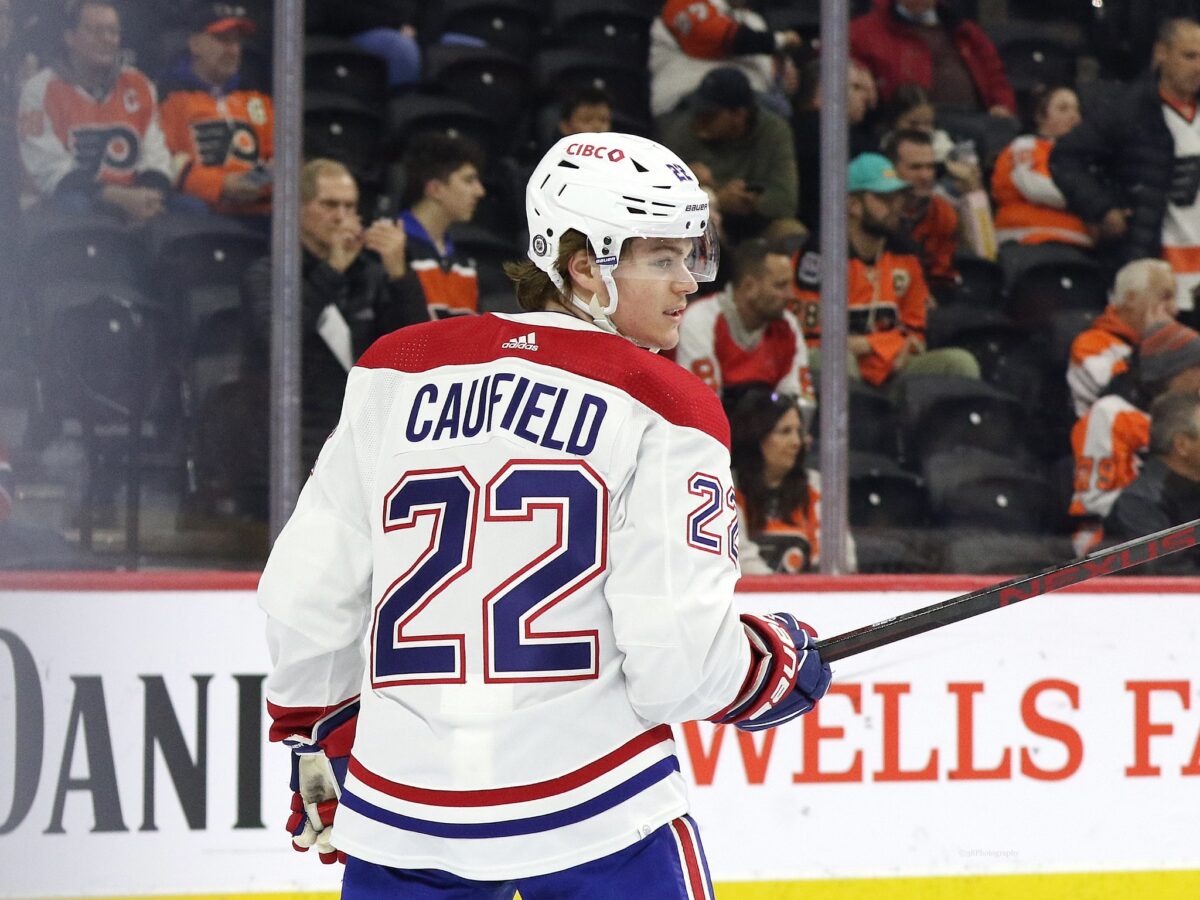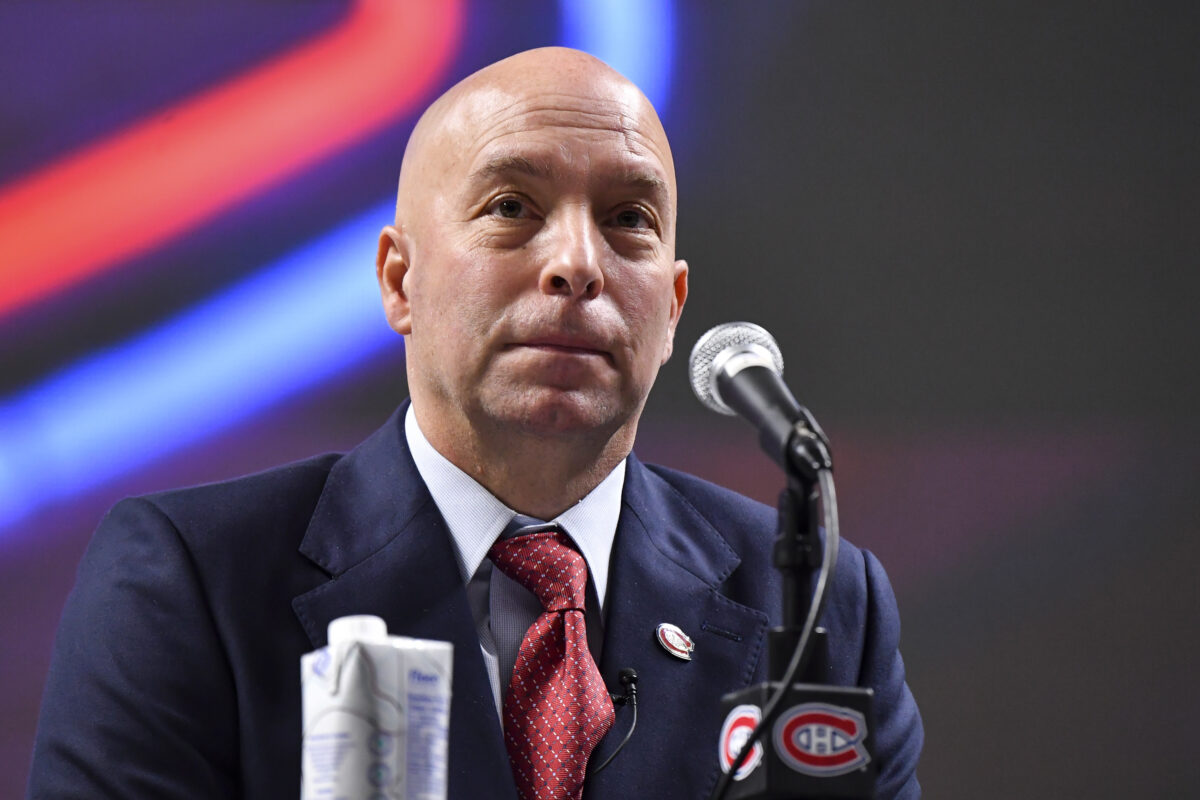The Montreal Canadiens didn’t necessarily underpay for Cole Caufield. It’s hard to argue that when the Habs re-signed him to an eight-year, $62.8 million extension ($7.85 million hit per season) and his best offensive season yielded a relatively modest 36 points, albeit in just 46 games. However, based on his superstar potential, there’s a good chance they didn’t overpay for the 22-year-old’s services either, making the deal a good one for both parties.

The benefits go beyond having locked up a potential superstar through the projected prime years of his career, though. Canadiens general manager Kent Hughes has put him and his team in a great position from the short into the long term based on the following top five benefits:
5. Entire Offseason Ahead for GM Kent Hughes
It was always going to be a (relatively) quiet offseason for Hughes, at least in theory. Obviously the Caufield extension was a high priority, but, now that that’s done, his only real priorities are re-signing fellow-restricted free agents Rafael Harvey-Pinard and Jesse Ylonen (in addition to making good use of his fifth-overall pick at the 2023 NHL Entry Draft, but it will be some years before we know how he and the Canadiens fare in that regard).

With effectively a full roster already and no expectations of contending in 2023-24, unrestricted free agency simply isn’t a necessity for the Canadiens. That gives Hughes a lot of time to devote to arguably luxury moves like trading Joel Edmundson and, if he’s feeling especially ambitious, Mike Hoffman and Joel Armia.
All that to say, Hughes’ offseason can certainly get busier. Now, with Caufield signed right away, he has more of an opportunity to continue to construct his team and get rid of contracts from the previous regime, in which case free agency would become more of an option.
4. No Cole Caufield Offer Sheet to Match
One other benefit of getting Caufield’s extension out of the way early is avoiding an offer sheet, something Hughes’ predecessor was unable to do with Jesperi Kotkaniemi a few seasons ago. Circumstances are obviously different in that Caufield has been more productive since joining the Canadiens. However, Kotkaniemi was still a former third-overall pick, who is also just 22 himself and still holds potential, now with the Carolina Hurricanes.

The Canadiens may have fewer doubts regarding Caufield’s ceiling, leading negotiations to go faster in this case. Even so, credit to Hughes (and Caufield) for closing negotiations as fast as they did. Ultimately, things could have dragged on to the point an offer sheet was at least theoretically possible.
Granted, reports indicated that wasn’t the case, leading this benefit to simply take the No. 4 spot on this list. However, even if there never was a realistic scenario where the Canadiens lost Caufield, exposing yourself to the mere risk of having to pay through the teeth to keep him would have been less than ideal for a variety of reasons.
3. Canadiens Keep Salary Structure Intact
With Caufield’s hit coming in just below captain Nick Suzuki’s $7.875 million per season, it’s clear what the Canadiens were trying to accomplish. They may yet fail in the coming seasons. In fact, it’s increasingly realistic they will eventually with inflation, but at least in the present they’ve kept their current salary structure intact.

At least right now, Suzuki is the top guy, as should be the case, based on his arguable most-valuable-player status on the team. So, even if it would have been easy to go over, especially with Caufield, who at one time was a few goals away from scoring 50 in 82 games under head coach Martin St. Louis, the end result is they’ve set a critical precedent.
So, from here on out, whenever someone is negotiating a new deal and feels like they deserve more, the Canadiens can simply ask rhetorically (and hopefully respectfully) if they honestly think they are worth more to the team than Suzuki… more of a team player than Caufield, who probably left at least a little money on the table.
2. Canadiens Go Long Term Instead of with Bridge Deal
True, there was always the option of going with a bridge deal, which would have meant a lower cap hit, but over just a few seasons. So, whereas one has to believe negotiations went fairly smoothly and pleasantly between both sides, the Canadiens would be taking a risk they, uh, wouldn’t in the relatively near future with a new set.
This way, everyone stays happy, especially Caufield in the short term, and potentially the Canadiens in the long term, as they seek to avoid another P.K. Subban situation from 2013. Then, Subban, a 23-year-old RFA, and the Canadiens engaged in negotiations that dragged into the lockout-shortened season.
The Canadiens eventually signed Subban to a two-year bridge deal ($5.75 million total), ending his holdout. However, that was really just the beginning of what you can probably call a saga at this point. Subban went on to score 38 points in 42 games that season not only hitting a whole new level in his play (having scored just 36 points in 81 games the previous season), but also eventually winning the James Norris Memorial Trophy.
So, when his two-year bridge deal came to term, the Canadiens ponied up significantly to the tune of $72 million over eight years… so, a $9 million hit, which is significantly more than Caufield’s effectively a decade later. That was even more money back then.
Had Bergevin gone long term, in retrospect he would have kept Subban’s hit reasonable, perhaps deciding to keep him instead of trading him for Shea Weber back in 2016. The point isn’t that Subban would have worked out better than Weber did with the Canadiens. It’s probably best to call the deal a wash at this point.
Related: Biggest Canadiens Hits and Misses Under Ex-GM Bergevin
Instead, the point is, the Canadiens should want to keep Caufield in the fold. They’re far from putting themselves in a position where they’ll have to make a difficult decision in just a few seasons at the height of his career (before his no-trade clause kicks in, in 2028-29). This way, he’ll realistically stay a Canadien… and the Canadiens are in a better position to stay competitive as a result.
1. More Cap Space Down the Road
It all goes back to Caufield’s reasonable cap hit and the large degree of potential there is for it to be a bargain in just a few seasons, similar to how Suzuki’s feels now. There’s obviously a long way to go in both regards, but just a single season into Suzuki’s eight-year, $63 million deal, there are few if any second-guessers. That wasn’t always the case, especially outside Montreal.

This time around, it’s even harder to find dissension regarding the sentiment this deal will eventually pay off. Caufield obviously isn’t a $7.85 million player right now, but he is a top player on the Canadiens. In that sense, it makes sense for him to be paid like one, while everyone expects him to end up a big-time goal scorer eventually, and, based on his production last season (26 goals in 46 games), sooner rather than later.
Even if that doesn’t end up the case, the Canadiens just locked up a top-line player for them right now at a reasonable rate. If it does become the case, they’ll have given themselves a lot more cap space with which to work than they should have, to properly build a contender. By agreeing to the amount he did, just under Suzuki’s, and for the term he did (up until 2031), Caufield looks to be fully on board. The Canadiens (and their fans) are clearly glad to have him.
